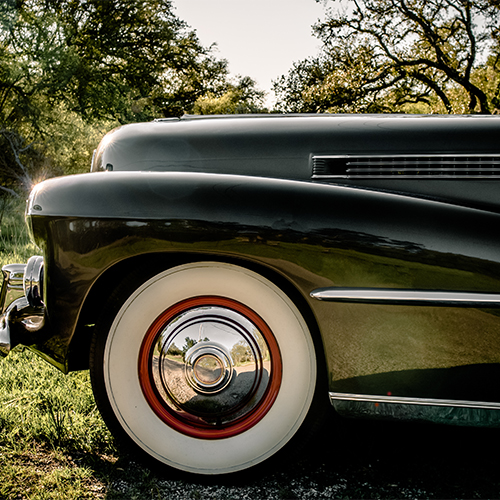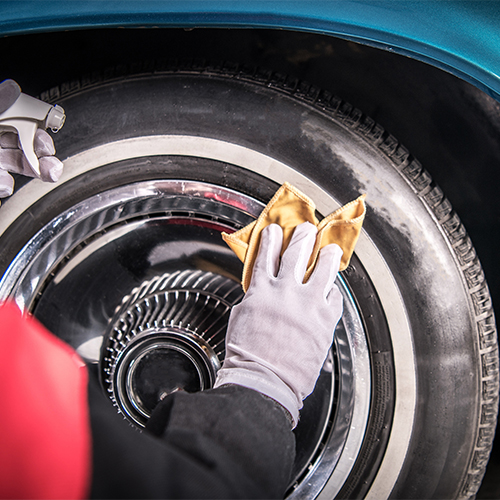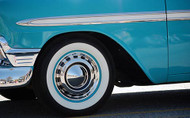Where Did All the Whitewalls Go?
Posted by Agota Szabo on Mar 24th 2022
Chances are you have seen a whitewall tire in your life.
While nowadays they are a rare sight, there was a time when they were the most popular choice for vehicles.
But, what exactly happened to white rubber car tires?
Let's talk about it.
What is a Whitewall Tire?
The term "whitewall tires" is for tire models which feature white stripes on their sidewalls. They are easily recognizable models, even if the side rubber only features a narrow white stripe.
Classic car models or traditional hot rods used these white tires. Striped whitewall tires used to be sold as original equipment tires up until the early 1960s. Therefore, they are a statement piece of any classic muscle car.
Nowadays, whitewall tires are mainly manufactured for luxury cars and not many tire brands spend the time and effort needed to create these models.

A Brief History of Whitewall Tires
White tires can be traced back to the beginning of the 1900s. Originally, white wall tires were mainly created for carriages. However, the rapid spread of automobiles created a need to make more durable tires.
With early tires, pure natural rubber (raw materials) was mixed with chemicals to achieve increased traction and a better tread life. One such chemical was zinc oxide (a pure white substance), which created the white color of the sidewall.

However, in later years zinc oxide was mixed with carbon black to manufacture tires with whitewall rubber and adjacent black rubber footprints. The first wide whitewall tires were popular and trendy and each automotive manufacturer used them as original equipment on their vehicles.
The Whitewall Tire Trend
Ford recognized the trend and became the first automaker to offer whitewall tires as a factory option with their products. This was in the 1930s and a whitewall tire set cost $11.25. These tires had their inner and outer sidewalls molded from white rubber.
Whitewall tires were popular as they offered nicer aesthetics when mounted on the wheel/rim. Wide whitewalls generally fell in the category of high aspect ratio tires. This tire sidewall simply looked nice on the cars, but it did not offer better performance than black tires.
In the 1940s and 1950s, when World War II and the Korean War came about, the popularity started to die down. Tire manufacturing technologies and personal preferences changed, causing whitewall tires to slowly diminish in numbers.

Over the years, white wall tires went through multiple design changes. For example, a 1" wide stripe floating in the middle of the sidewall replaced the wide white stripe design.
However, the single-sided whitewall remained an option with some classic car models until the end of the 1970s.
If you are interested in a more in-depth look at the history of white walls, check out our post.
Whitewall Tire Today
Over the years, white walls have all but disappeared from the market. You will not find them on any car assembly line. Yet, they still exist!
Most whitewall tires are now sold on the modified car market and at specialty outlets for car enthusiasts. Most hot rods, low riders, and custom cars will most likely be equipped with whitewall tires.
Whitewall tires were replaced by black walls. This switch to using full carbon black tires started in the 1970s when radial tires became more widespread. These tread compounds provide the durability and service life necessary for a safer performance. Additionally, they are also affordable.

Most whitewall tires on the modern market come with increased prices. This is due to their niche application. While it is not impossible to find models for $60 per tire, their price tends to rest around $150.
Why did White Wall Tires Disappear?
There are different factors which have reduced the popularity of whitewall tires.
From changing tire manufacturing technologies to tire structures, the increased use of black rubber to public opinion, many factors have aided in the decrease of this trend. Yet, they are still available on the market.
Wide whitewall tires reached the end of their celebrated status, but their descendants are still being sold. Various tire manufacturers offer different variations of the whitewall tire, even if their entire sidewall isn't white.
By looking at the market, it can be seen that white rubber is still in use. For a while the narrow whitewall was popular, later tires with triple white stripe variations were trendy. The raised white letter or white lettering is the newest style, which is more widespread.
Tire brands also produce tires with a thin gold stripe line sidewalls.

However, white wall tires need to be kept clean since the white stripe on the sidewall can easily turn yellow from regular use. So, if you are a lucky one who uses such tires, you will need to know how to clean them properly. Don't worry, we've got you covered! Just take a peek at our guide to cleaning white wall tires!
Frequently Asked Quetions (FAQs)
Why did white wall tires disappear?
White wall tires began to disappear from the market when manufacturers began to decrease the height of the tires. The thick white stripe along the sidewalls did not allow tire brands to create tires with lower sidewall profiles. For this reason, entirely black tires became popular.
When did they stop making whitewall tires?
Most manufacturers had stopped making whitewall tires by the beginning of the 1960s. This trend is noticeable in the 1950s as well, when the whitewall stripe width began to shrink. The biggest shift happened in 1962 when regular cars got equipped with black rubber tires.
Can you paint your tires?
Yes, the lettering on the sidewalls can be painted. White paints are most widely used, which gives the tires an old-timey look. However, be sure to only use oil-based paint, as other types can dry out the rubber.
















